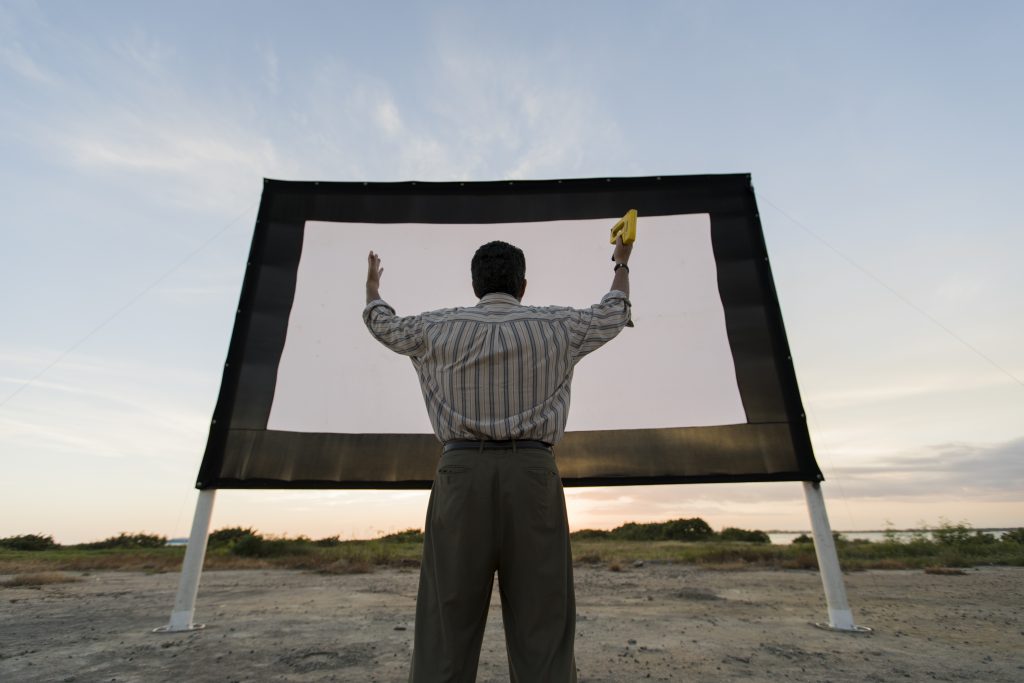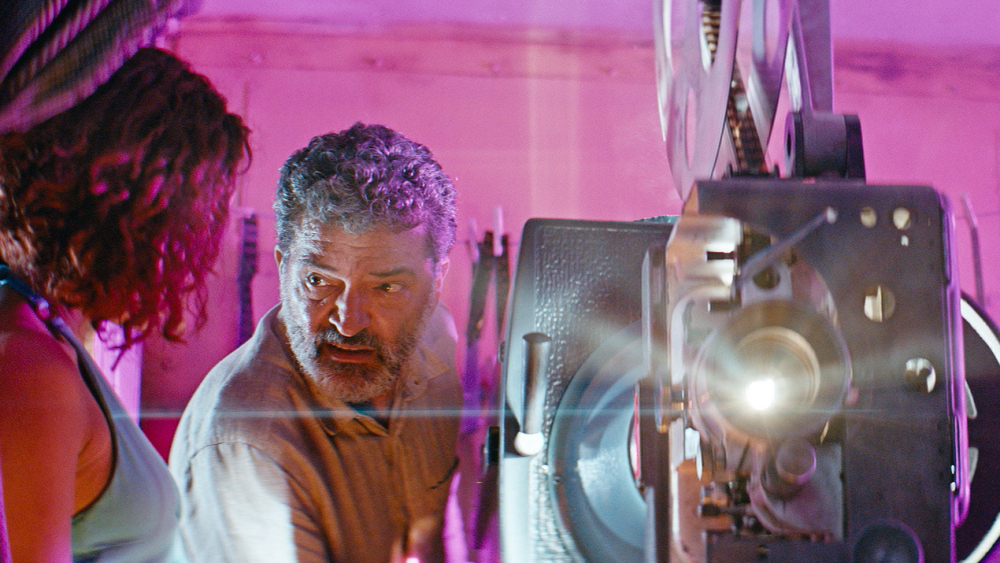With the growing threat that streaming services and monolithic franchises pose to our cinematic heritage, José María Cabral’s El proyeccionista (The Projectionist) comes as a timely entreaty for the sanctity of tradition. The ways it goes about paying homage to the pleasures of celluloid, however, are innovative, unconventional and potentially off-putting for those in search of something akin to say, the feel-good melodrama of Cinema Paradiso (1990), which shares with Cabral’s film little else beyond its projectionist main character.
Cabral bewitches and baffles with a dark story that has all the subliminal force of a recurring dream.
A gutsy tribute to the ways in which we psychologically invest ourselves in moving pictures, this Dominican entry for the Academy Awards’ Best International Film category employs old tools of the trade (the film is shot in widescreen, not digital for instance) to original effect. But rather than a gentle swan song to a fading craft, Cabral bewitches and baffles with a dark story that has all the subliminal force of a recurring dream.
Eliseo (Félix Germán) is the titular projectionist, a world-weary man in his 50s or 60s that manages a traveling cinema from a truck. Audiences sit shotgun beside the grump as he traverses the Dominican Republic holding public screenings in backwater parts of the country with no movie theaters, getting locals to assist with promotion and setup for a cut of the pay. In parts, the film plays like a rural road movie, with Eliseo’s mud-stained blue vehicle driving through dirt roads and across bright tropical greenery and fields before settling into town centers — cement structures or makeshift boardwalks where itinerant kids and young people naturally congregate. The sky seems perpetually bright blue overhead in the daytime and yet the prevailing color scheme — an azure glow against juxtaposing dark shadows — recalls the inside of a theater, the soft light reflected from the screen bathing the audience, or in this case, the film’s characters, in monochrome.

But the importance of this theatrical setting goes beyond Eliseo’s livelihood — it’s a space that comes to represent the protagonist’s inner life, his loneliness and his desires, as well. We soon learn that Eliseo harbors a collection of old stock footage of a beautiful mystery woman that he projects to keep him company. Images of her eating, dancing and bathing are played over and over again, and Eliseo matches her activities to parallel his own while a melancholic ambient score heightens the emotional stakes. Unsurprisingly, he also masturbates to the woman, a literal expression of his erotic fixation.
Cabral understands that cinema itself teems with lust, evoking dream images that we as audiences often fetishize but that are held at a distance as completely unattainable. Eliseo’s relationship with his phantom dream lady embodies this frustrated desire, but he is complacent and unmotivated to seek companionship elsewhere. That is until an accident ruins the bulk of his footage, which sends him on a quest to uncover the woman’s identity and whereabouts.
Germán plays Eliseo as gruff and abrasive, seemingly unaccustomed to interactions outside of his business obligations. He’s convincing as a sad, perpetually frowning old man whose love of life seems to be annihilated, save for whatever bitter joy he derives from his mystery woman. As a result, Eliseo is hardly a sympathetic character and his desperate searching for the lost woman registers as mildly disturbing, borderline predatorial — considering the many ways he uses, perhaps abuses, her image for his own purposes. At the same time, the intensity with which he conducts his hunt also gives the film the shape of a noir psychodrama with the promise of a treacherous hidden secret at the tail-end.

The Projectionist, however, takes its time to reach its climactic final scene, interweaving troubles of the trade and a run-in with a feisty young woman, Rubi (Cindy Galán), whom Eliseo eventually, begrudgingly, takes on as his apprentice. In Rubi, Eliseo experiences female companionship with flesh and bones. Galán injects a welcome dose of charisma and resilient, vivacious energy that is otherwise absent — perhaps Cabral wants to suggest that this sort of youthful spirit needs to be injected in cinema itself. In any case, if Eliseo’s attitude is any indication, the tired projectionist has long shrugged off the import of cinema’s communal spirit. Meanwhile, Rubi is enamored with the cinema truck’s ability to draw in crowds and assemble people to partake in a common activity. There’s no Netflix out here, but the scourge of television nevertheless hinders the business’s success — Eliseo and Rubi take it upon themselves to better their opportunity, by cutting a neighborhood’s electricity for instance.
Perhaps the future of cinema, like Eliseo’s, is simply bleak and muddled.
These misadventures eventually lead up to a bravado final sequence that has Eliseo restlessly projecting weathered footage upon different walls of an abandoned home that once belonged to his beloved, reenacting a crime that took place there by the cobbled-together images at his disposal. The scene is a bit of a narrative stretch, and too uncritically elevates Eliseo’s bizarre desperation as admirable detective work without truly getting into why, but editor Nacho Ruiz makes completely thrilling and tense what is essentially just a guy running around a small space with a projector.
The big reveal is ultimately a bit anticlimactic, not least of all because it happens so abruptly and shows little interest in exploring the emotional ramifications it may have on Eliseo and his way of life. Perhaps the future of cinema, like Eliseo’s, is simply bleak and muddled. Yet the film ends on a note of ambiguity. Again Eliseo finds himself alone, but this time he’s looking out at an open road at daybreak — natural colors spill in, and the camera slowly begins to round the corner. A curse has been lifted.







